We pick out the most impressive projects of 2013, from a graceful City tower (that doesn’t melt cars) to the world’s first zero-carbon dairy
It was always going to be a tough call for 2013 to match the highs of the previous year. With the Olympics and Diamond Jubilee, the celebratory spirit that prevailed throughout 2012 was matched by several milestones in construction. With the completion of major projects such as the King’s Cross redevelopment and the Olympic park, as well as the acceleration of government initiatives such as standardised schools, 2012 was indeed a landmark year for the industry.
Inevitably 2013 has been more low-key but it has probably provided a more representative example of the sedate post-Olympic and post-recession times that are inevitably to follow. An initially sluggish recovery appears to be quickening in pace, with London at the helm of growth, a scenario particularly prevalent in the housing sector.
But beyond housing, there are also encouraging signs of life across the construction industry. Innovation appears to be a driving force within the commercial sector, as developers seek to provide offices that match the more streamlined economic and technical priorities the age of austerity has imposed. And despite appearances that might be to the contrary, the cultural sector appears to sustaining healthy construction activity.
But it is infrastructure that has led the way in 2013. Projects like Crossrail, the controversial HS2 and the redevelopment of key terminals such as Birmingham New Street demonstrate the government’s ongoing commitment to the sector and with the toxic issue of aviation expansion still unresolved, this trend looks set to continue well in to 2014.
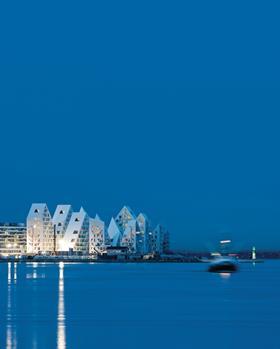
Housing - Iceberg
In London, the announcement of massive schemes such as the redevelopment of Battersea Power Station and Earl’s Court is indicative of a stubbornly buoyant housing sector that has largely shielded the city’s economy from the worst ravages of the downturn. This - along with a mayoral London Plan that appears to be making significant inroads in the quest to improve space and design standards - explains how the capital has consolidated its role as the nucleus of post-recession UK housing activity over the past year.
While London’s uber-resilient housing market is not exactly being replicated in the regions, housebuilders are still leading the charge out of the recession. There have been several notable examples of high-quality design, in particular schemes inspired by vernacular contexts such as Alison Broskes’ Newhall BE in Harlow and Proctor and Matthews’ Hargood Close.
It may seem strange, therefore, to look abroad for a star housing scheme of the year. But the Iceberg in Aarhus, Denmark - designed by four architectural practices: CEBRA, JDA, SeARCH and Louis Paillard - represents much that UK housing can learn from. As well as being ambitious and high-quality modern architecture, it is an example of institutional private rental investment - a tenure model that is still rare in the UK but could well become a growth market. With London and the South-east still crippled by a housing shortage that is particularly acute in affordable housing, more long-term private rental opportunities could stem house price inflation and incentivise construction of a new typology of housing.
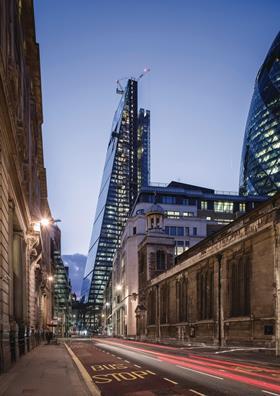
Commercial - Leadenhall building
Many Londoners are probably under the impression that the fortunes of the commercial market have never wavered, as the skyline and news pages have been dominated by the construction of two very tall and very visible City towers. The Leadenhall building and 20 Fenchurch Street - or the Cheesegrater and Walkie Talkie as they are more commonly known - topped out this year, with the latter attracting most of the attention.
All the furore surrounding the Walkie Talkie’s bulging facade and its ability to melt cars at 20 paces has meant that the construction of Richard Rogers’ Cheesegrater has passed almost unnoticed. This is a shame as the building has been as sensitively designed as a tall tower can be. Its triangular shape preserves the view of St Paul’s from Fleet Street and the public will benefit from a huge double-height public space under the building when it completes next year. This is in marked contrast to most recent towers that reserve “public space” for exclusive bars or viewing platforms at their summits.
The building takes prefabrication to a new level with the number of workers on site reduced by half. The floor slabs have been constructed with precast slabs, a first for a high-rise, and the north core was assembled from elements that included the structure, floors and services in one unit.
Happily these two additions to London’s skyline herald a real resurgence in the office market. Kieran Timberlake’s new US embassy, Kohn Pedersen Fox’s Scalpel tower and Make’s London Wall Place will all start on site next year, followed by Google’s HQ - once the client has settled on a design and contractor. The speculative office sector is set to bounce back too, with Derwent’s White Collar Factory, an innovative take on the warehouse conversion set to start on site next year. And there’s activity further afield, with large schemes set to break ground in Manchester and Yorkshire and Humberside.
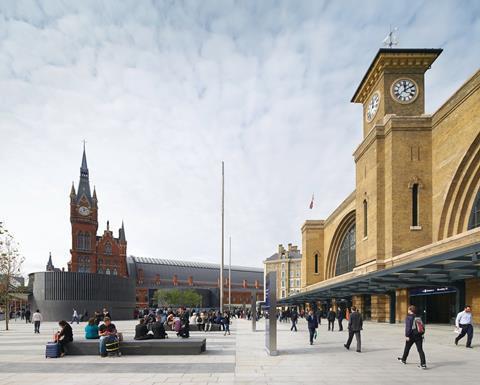
Infrastructure - King’s Cross Square
The infrastructure sector has escaped the worst of the downturn, with Crossrail, Heathrow Terminal 2 and improvements to the rail network keeping the sector afloat. The activity will continue with the electrification of the Great Western Railway and upgrading of London Bridge station. Roads are receiving a fillip too, with improvements to the M74 in Scotland, the replacement for the Forth road bridge and the M25 managed motorway works.
There is a perception that the coalition has abandoned its commitment to the green agenda, with the dilution of the Energy Companies Obligation for home improvements and the cancellation of RWE’s Atlantic Array wind farm. But other schemes are going ahead, notably the £700m Humber Gateway offshore wind farm, which is under construction.
The most obvious manifestation of infrastructure spending is the refurbishment of large city-centre railway stations. Works at Edinburgh’s Waverley station are well advanced and the first phase of Birmingham New Street opened in April. This marked the transformation of the dungeon-like sixties concrete monstrosity, which symbolised all that was bad about Birmingham, to a light, bright station fit for the 21st century. The futuristic stainless-steel cladding is advancing, banishing the old car park style building into distant memory.
The most significant improvement was the completion of the new King’s Cross Square in London. This was the final chapter in the renaissance of King’s Cross station and next-door neighbour St Pancras. This area used to be a byword for drugs and prostitution; now it is firmly established as a vibrant quarter of London, proving that the return on investment in infrastructure is much bigger than the cost of the works.
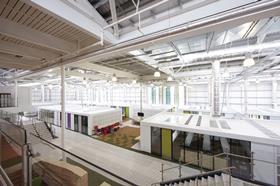
Education - Leeds East primary school
After a few years of frantic activity, it’s fair to say that, in design terms at least, the education sector has stagnated. Controversial as it was, the scrapped Building Schools for the Future did provide an array of showpiece buildings and represented, for some, a new dawn for the sector. Last year, however, standardisation took centre stage, with its diametrically opposite creed of fiscal restraint and supply-chain efficiency. The government’s free school agenda, meanwhile, does not as yet appear to be naturally inclined towards high-quality design.
Which is why it was truly startling to come across a genuine example of creativity in the education sector this year. Designed by Maber Architects, Leeds East primary school is the first in the UK to be constructed from an innovative pod system developed by Maber, Interserve and specialist partition manufacturer Norwood. Rather than using conventional fixed-frame construction, PodSolve comprises a series of structurally independent steel-framed classrooms, which can easily be assembled, dismantled and relocated. Essentially these pods can be placed in any building, providing a flexible education environment that can be adapted to alternative uses as local requirements evolve. Leeds East proves that economy need not stifle innovation.
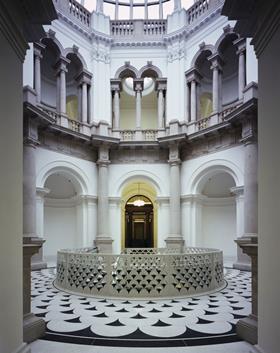
Cultural - Tate Britain
There is a perception that the heady days of rampant construction activity within the cultural sector are over. The dawn of the new millennium, when it seemed as if every town or city had adopted a new or refurbished gallery or museum, is just a faint and distant memory. Instead we have a cultural sector diminished by the weight of austerity and a Department for Culture, Media and Sport forced to bear some of the most savage cuts in funding dispensed to any government department in the 2010 spending review.
But while there was undoubtedly less spending on cultural buildings in 2013 than 2003, this year still saw the completion of a number of landmark cultural projects. Liverpool and Birmingham were given sparkling new central libraries, Portsmouth’s iconic Mary Rose museum opened, and construction has proceeded apace on major extensions to the Victoria and Albert Museum, British Museum and the Tate Modern.
But it is the reopening of the latter’s elder sibling, up-river in Millbank, that arguably deserves the title of the most significant cultural project of the year. Caruso St John’s extensively reconfigured Tate Britain - the result of a seven-year overhaul - is almost a throwback to bygone times: a major national institution given a lavish, multimillion-pound renovation by a signature architect. But one key aspect of the gallery is a reminder of the more straitened economic realities that many cultural institutions are forced to face: only 5% of its £45m budget came from public funds, with the rest being sourced from private donations.

Industrial - Arla Foods
The industrial sector has been in a similar state to the commercial market - very quiet until recently. There are signs of life, particularly in the distribution sector, with several large sheds starting on site including a £90m Sainsbury’s distribution centre in Warwickshire, Prologis Park in Bedfordshire and Orion Park in London.
And this traditionally less-than-glamorous sector is becoming more exciting too. Arla Foods has built the world’s first zero-carbon dairy near Aylesbury, which started operating earlier this year. The £150m facility can churn out
1 billion litres of milk a year, enough for the south-east of England. It gets to zero carbon by reducing energy use first - it is 70% more efficient than an equivalent state-of-the-art dairy. A lot of thought went into ensuring complementary processes were sited close together, refrigerated milk was stored in north-facing areas and gravity rather than pumps were used where possible. And heat and power come from CHP, which is partially powered using biogas produced from waste milk products via an aerobic digester.
Remaining emissions will be mitigated by measures that could include supplying low-carbon heat and power to an adjacent business park and using waste heat from refrigeration units to heat buildings locally.
The project demonstrates that zero-carbon factories can be a reality - an achievement that the government should note as it ponders how to make all new buildings zero-carbon from 2019.































No comments yet